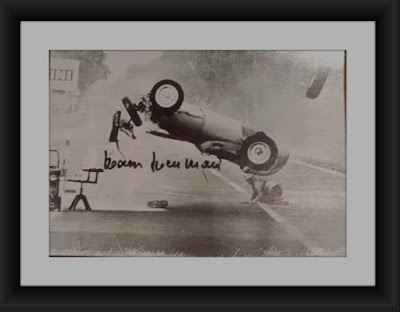Hans Herrmann (born 23 February 1928) is a retired
Formula One and
sports car racing driver from
Stuttgart,
Germany.

In F1, he participated in 19 World Championship Grands Prix,
debuting on 2 August 1953. He achieved 1 podium, and scored a total of
10 championship points.
In sports car racing, he also scored the first overall win at the
24 Hours of Le Mans for
Porsche in 1970, in a
Porsche 917.
From 1954 to 1955, he was part of the
Mercedes-Benz factory team, as a junior driver behind
Juan Manuel Fangio,
Karl Kling,
Hermann Lang and later
Stirling Moss. When the
Silver Arrows came back for the 1954
French Grand Prix to score a 1–2 win, Herrmann drove the fastest lap but had to retire. A podium finish at the
1954 Swiss Grand Prix was his best result in that year as he had to use older versions of the
Mercedes-Benz W196, or the least reliable car.
In the
1955 Argentine Grand Prix
his teammates Kling and Moss had to abandon early due to the extremely
hot conditions on the southern hemisphere in January. Herrmann was
called in to share his car with them for a 4th-place finish, giving one
point each. Fangio won with two laps more.
Hans was quick in the 1955
Mille Miglia with the
Mercedes-Benz 300 SLR, comparably or even faster than Moss, but was less lucky than in 1954, as he had to abandon the race.

A crash in practise for the
1955 Monaco Grand Prix put Herrmann out for the ill-fated 1955 season, even though a comeback in the
Targa Florio was intended.
The next years saw Herrmann racing for many marques, in F1 for
Cooper,
Maserati and
BRM. In Berlin's
AVUS during the
1959 German Grand Prix
the brakes of his BRM failed, he crashed in a spectacular way, being
thrown out of the car and sliding along the track with the car
somersaulting in the air.

With different versions of the
Porsche 718 being used as a sportscar and as a
Formula Two car, Herrmann scored some wins for Porsche, mainly both the 1960
12 Hours of Sebring and
Targa Florio. When the open wheeled single seater version of the Porsche 718 became eligible for
Formula One in 1961 due to the rule changes, the results in F1 were disappointing. Herrmann finished 15th (last) in the
1961 Dutch Grand Prix,
which was one of only two races in F1 history to have no retirements.
He left Porsche at the beginning of the 1962 season feeling that he as a
local from Stuttgart was
No Prophet In His Own Land compared to Californian
Dan Gurney and 1959 GP-winner
Jo Bonnier from Sweden. Gurney scored two F1 wins (one non-championship) with the new
Porsche 804, but Porsche retired from F1 anyway at the end of 1962.
In 1966 he returned to Porsche for a comeback in the
World Sportscar Championship, as Porsche started a serious effort there. Following several podium finishes with the still underpowered two liter
Porsche 906 and later models, he won the 1968
24 Hours of Daytona in a 907 as well as the
Sebring 12 Hours again, now together with Swiss
Jo Siffert. The overall win of the
1000km Nürburgring always eluded him, even though Herrmann had taken part in each of these races at the
Nürburgring since they were introduced in 1953, and had finished second three times in a row from 1968 to 1970, behind teammates
Jo Siffert and/or
Vic Elford.

Herrmann missed the win in the 1969
24 Hours of Le Mans with a
Porsche 908 by only 120 meters
[1], but it was he who finally scored the long-awaited first overall victory at the
Le Mans 24 Hours for Porsche in 1970. He was assigned to
Porsche Salzburg,
the Austria-based factory-backed team owned by the Porsche family,
which mainly entered cars painted red and white, the Austrian colors. In
heavy rain, he and his teammate
Richard Attwood survived with their
Porsche 917K #23 as the best of only seven finishers.
Half jokingly, Herrmann had promised to his wife before the Le Mans
race that he would retire in case of a win there. Having witnessed fatal
accidents of colleagues too many times, e.g. before the
1969 German Grand Prix when his teammate and neighbor
Gerhard Mitter
died, the 42-year-old announced his retirement on TV, after having
driven the winning car in a parade through Stuttgart from the factory to
the town hall. To get out of his contract with
Porsche Salzburg, Herrmann had to recommend a replacement driver to Luise Piech.
Using his contacts, Herrmann built a successful company for
automotive supplies. He was kidnapped once in the 1990s and kept in a
car trunk for many hours before escaping.
Herrmann has remained engaged in the racing community through his
retirement, demonstrating historical cars at events such as the
Solitude-Revival.
[
 After an unassuming playing career as a right-back,
Eriksson went on to experience major success in club management between
1977 and 2001, winning 18 trophies with a variety of league clubs in
Sweden, Portugal and Italy; he became the first manager to conquer league-and-cup doubles in three countries.[2] In European competition, he won both the UEFA Cup and the European Cup Winners' Cup (the last edition of the latter trophy before its abolition) and reached the final of the European Cup
After an unassuming playing career as a right-back,
Eriksson went on to experience major success in club management between
1977 and 2001, winning 18 trophies with a variety of league clubs in
Sweden, Portugal and Italy; he became the first manager to conquer league-and-cup doubles in three countries.[2] In European competition, he won both the UEFA Cup and the European Cup Winners' Cup (the last edition of the latter trophy before its abolition) and reached the final of the European Cup





